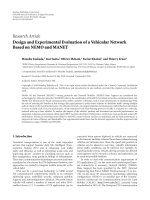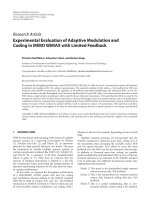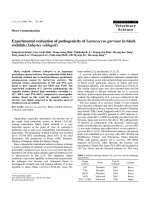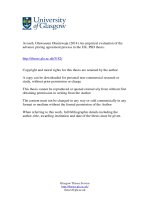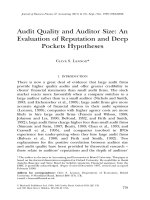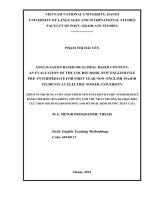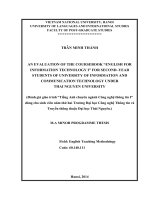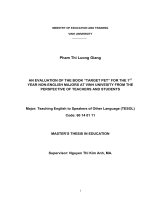Experimental evaluation of FRP strengthened concrete bridge girders
Bạn đang xem bản rút gọn của tài liệu. Xem và tải ngay bản đầy đủ của tài liệu tại đây (4.49 MB, 99 trang )
EXPERIMENTAL EVALUATION OF FRP STRENGTHENED
CONCRETE BRIDGE GIRDERS
By
RAKESH B JAYANNA
Presented to the Faculty of the Graduate School of
The University of Texas at Arlington in Partial Fulfillment of the Requirements
for the Degree of
MASTER OF SCIENCE IN CIVIL ENGINEERING
THE UNIVERSITY OF TEXAS AT ARLINGTON
AUGUST 2015
ProQuest Number: 1599164
All rights reserved
INFORMATION TO ALL USERS
The quality of this reproduction is dependent upon the quality of the copy submitted.
In the unlikely event that the author did not send a complete manuscript
and there are missing pages, these will be noted. Also, if material had to be removed,
a note will indicate the deletion.
ProQuest 1599164
Published by ProQuest LLC (2015). Copyright of the Dissertation is held by the Author.
All rights reserved.
This work is protected against unauthorized copying under Title 17, United States Code
Microform Edition © ProQuest LLC.
ProQuest LLC.
789 East Eisenhower Parkway
P.O. Box 1346
Ann Arbor, MI 48106 - 1346
Copyright © by Rakesh B Jayanna 2015
All Rights Reserved
ii
Acknowledgements
I would like to greatly and sincerely thank Dr. Nur Yazdani for his guidance,
understanding, and patience during my graduate studies at University of Texas at
Arlington. I am very glad that I got this opportunity to work for Dr. Yazdani in this
research. For everything you have done for me, Dr. Yazdani, I thank you. I would also
like to thank all the members of DR. Yazdani research group, Narasimha Reddy, Vinod
Reddy, Mina Riad, Rakesh K R, Istaq Hasan and most specially Eyosias Beneberu who
helped me lot as a mentor until the end the research.
I thank Dr.Chao and his research group for helping me in experimental setup
especially Chatchai Jiansinlapadamrong. I would also like to thank my Committee
members Dr. Najafi, Dr. Mohammad Razavi for their precious time.
Finally, and most importantly, I would like to thank my mother for her support,
encouragement; patience and her love were the bedrock upon which my master’s degree
is been so successful and I thank her for having faith in me and allowing me to be as
ambitious as I wanted.
August 10, 2015
iii
Abstract
EXPERIMENTAL EVALUATION OF FRP STRENGTHENED CONCRETE BRIDGE
GIRDERS
Rakesh B Jayanna, MS
The University of Texas at Arlington, 2015
Supervising Professor: Nur Yazdani
This report presents the details of research study on the use of Carbon Fiber Reinforced
Polymers (CFRP) sheets to strengthen the Pre-stressed concrete TxDOT Tx-28 bridge
girders in flexure and shear. Four girders were subjected to destructive test in this
research. First girder as control specimen without any CFRP applied on it, Second and
third girders were flexural strengthened for one and two layers of CFRP and the forth
girder is shear strengthened with one layer CFRP. Experimental phases along with the
comparison of test results in terms of flexural and shear capacity of bridge girders, strains
and deflections are discussed with reference to control and CFRP strengthened
specimens. The CFRP strengthening was designed based on the ACI 440
recommendations. The report details the installation process as well as a load-testing
program utilized to assess the effectiveness of the strengthening system. The installation
process was found to be rapid and simple. The bonding between the FRP installed and
the concrete surface is verified by pull off test. Adding to this in order to monitor the strain
and displacement, we had strain gages on the surface of FRP at the tension and
compression zones of the girders and two transducers near the supports and two more
transducers at the center. Good agreement was obtained with the experimental and
theoretical findings of strength, strains and deflections. Overall, the strengthened girders
behaved as predicted when subjected to the design loads. The detailed design of FRP
strengthening is system is reported in this report.
iv
Table of Contents
Acknowledgements .............................................................................................................iii
Abstract .............................................................................................................................. iv
List of Illustrations ............................................................................................................. viii
List of Tables ......................................................................................................................xii
Chapter 1 INTRODUCTION ................................................................................................ 1
1.1
Background and Research Scope ......................................................................... 1
1.2 Research Objectives ................................................................................................ 2
Chapter 2 LITERATURE REVIEW ...................................................................................... 3
2.1
Introduction ........................................................................................................ 3
2.2
CFRP Laminate strengthening .......................................................................... 3
Chapter 3 Material Specifications ....................................................................................... 6
3.1
Specimen description ........................................................................................ 6
3.2
Carbon fiber fabric ............................................................................................. 7
3.3
Epoxy ................................................................................................................. 8
3.4
Strain Gages ...................................................................................................... 9
1.
3.5
3.4.1 Installation of Strain gages ..................................................................... 10
Linear varying differential transformers (LVDT’s) ............................................ 13
Chapter 4 Specimen Preparation and Test setup ............................................................. 14
4.1
Introduction ...................................................................................................... 14
4.2
Girder strengthening ........................................................................................ 16
4.2.1 Surface Preparation ........................................................................................ 16
4.2.2 Application of FRP ........................................................................................... 17
4.2.3 Anchorage ....................................................................................................... 20
4.3
Bond behavior of FRP – Concrete surface ...................................................... 20
v
4.4
Strain gage layout ............................................................................................ 22
4.5
LVDT Layout .................................................................................................... 24
4.6
Experimental setup .......................................................................................... 25
Chapter 5 Preliminary analysis ......................................................................................... 29
5.1
Introduction ...................................................................................................... 29
5.2
Un-strengthened Girder analysis ..................................................................... 29
5.2.1
Flexure Strength .......................................................................................... 29
5.2.2
Shear Strength ............................................................................................ 29
5.3 Strengthened Girder Analysis ................................................................................. 30
5.3.1
Flexural strengthening ................................................................................. 30
5.3.2
Shear Strengthening ................................................................................... 31
Chapter 6 Experimental Results ....................................................................................... 32
6.1
Introduction ...................................................................................................... 32
6.2
General Observations ...................................................................................... 32
6.2.1
Cracks and Failure Modes .......................................................................... 32
6.2.1.1 Flexure ..................................................................................................... 33
6.2.1.2 Shear ........................................................................................................ 44
Chapter 7 Test Results ..................................................................................................... 46
7.1
Control Specimen (G1C) ................................................................................. 46
7.2
Girder, Flexure 1 layer (GF1) .......................................................................... 48
7.3
Girder, Flexure 2 layers GF2 ........................................................................... 50
7.4
Girder, Shear 1 layer GS1 ............................................................................... 53
Chapter 8 Discussions ...................................................................................................... 56
8.1
Introduction ...................................................................................................... 56
8.2
Analysis of Strength of Girders ........................................................................ 56
vi
8.2.1
Comparison of Strength of Control and GF1 ............................................... 56
8.1.2
Comparison of strength of control and GF2 ................................................ 58
8.2
Analysis of Deflections .................................................................................... 59
8.3
Importance of Anchorage ................................................................................ 60
8.4
Analysis of Strains of the experimental results ................................................ 62
8.5
Comparison of GS1 FRP strengthened with the un-strengthened .................. 63
Chapter 9 Conclusions ...................................................................................................... 64
9.1
Research Conclusions ..................................................................................... 64
9.2
Recommendations and Future Work ............................................................... 64
Appendix A Flexural Strengthening of Pre-stressed concrete Tx-28 Girder
with CFRP sheet ............................................................................................................... 65
Appendix B Shear Strengthening of Pre-stressed concrete Tx-28 Girder with
CFRP sheets ..................................................................................................................... 71
References ........................................................................................................................ 75
Biographical Information ................................................................................................... 86
vii
List of Illustrations
Figure 3-1 – Girder Cross section ....................................................................................... 6
Figure 3-2- Girder elevation ................................................................................................ 7
Figure 3-3- Bar specifications ............................................................................................. 7
Figure 3-4- Carbon fiber fabric ............................................................................................ 8
Figure 3-5- Epoxy components ........................................................................................... 9
Figure 3-6- Strain Gages................................................................................................... 10
Figure 3-7- Surface preparation ........................................................................................ 10
Figure 3-8-Surface preparation ......................................................................................... 11
Figure 3-9- Surface preparation ........................................................................................ 11
Figure 3-10-Gage layout ................................................................................................... 11
Figure 3-11-Gage application ........................................................................................... 12
Figure 3-12- Gage application .......................................................................................... 12
Figure 3-13- Gage application .......................................................................................... 12
Figure 3-14- Transducer ................................................................................................... 13
Figure 4-1- Control Girder ................................................................................................. 14
Figure 4-2- Girder, Flexure, 1 layer ................................................................................... 15
Figure 4-3- Girder flexure 3 layers .................................................................................... 15
Figure 4-4- Girder, shear, 1 layer ...................................................................................... 16
Figure 4-5- Surface preparation ........................................................................................ 16
Figure 4-6- Mixing of epoxy .............................................................................................. 17
Figure 4-7- Application of epoxy to girders ....................................................................... 18
Figure 4-8 – Applying Epoxy on FRP ................................................................................ 18
Figure 4-9 – Applying thick paste of Epoxy with Silica ..................................................... 19
Figure 4-10 – Installation of saturated FRP on Girders .................................................... 19
viii
Figure 4-11 – Flexure Anchorage ..................................................................................... 20
Figure 4-12 – Samples from the Pull off test..................................................................... 22
Figure 4-13 – Stain gage layout – GC .............................................................................. 22
Figure 4-14 – Strain gage layout – GF1............................................................................ 23
Figure 4-15 - Strain gage layout – GF2 ............................................................................ 23
Figure 4-16 - Strain gage layout – GS1 ............................................................................ 24
Figure 4-17 – LVDT Layout for GC, GF1 and GF2 ........................................................... 24
Figure 4-18 – LVDT Layout for GS1 ................................................................................. 25
Figure 4-19 – Experimental setup ..................................................................................... 25
Figure 4-20 – Experimental setup ..................................................................................... 26
Figure 4-21 – Experimental setup ..................................................................................... 27
Figure 4-22 – Setup Longitudinal section ......................................................................... 27
Figure 4-23 – Setup Cross section ................................................................................... 28
Figure 6-1- Observed first crack at 94 kips ....................................................................... 33
Figure 6-2 – Observed cracks due to loading GC ............................................................ 34
Figure 6-3 - Observed cracks due to loading GC ............................................................. 34
Figure 6-4 - Observed cracks due to loading GC ............................................................. 35
Figure 6-5 -Observed cracks due to loading GC .............................................................. 35
Figure 6-6 -Observed cracks due to loading GC .............................................................. 36
Figure 6-7 - Observed cracks due to loading GC ............................................................. 36
Figure 6-8 - Observed cracks due to loading GC ............................................................. 37
Figure 6-9 - Observed cracks due to loading at first force drop GC ................................. 37
Figure 6-10 – Observed cracks due to loading GF1 ......................................................... 38
Figure 6-11 -Observed cracks due to loading GF1 ........................................................... 38
Figure 6-12 – FRP debonding at maximum loading GF1 ................................................. 39
ix
Figure 6-13 – FRP Debonding at Maximum Loading GF1 ............................................... 39
Figure 6-14 - FRP debonding at maximum loading GF2 .................................................. 40
Figure 6-15 – Observed cracks due to loading GF2 ......................................................... 41
Figure 6-16 - FRP debonding at maximum loading GF2 .................................................. 42
Figure 6-17 - FRP debonding at maximum loading GF2 .................................................. 43
Figure 6-18 - FRP debonding at maximum loading GF2 .................................................. 43
Figure 6-19 – Loading setup for shear test GS1 ............................................................... 44
Figure 6-20 – Observed cracks due to loading GS1 ......................................................... 44
Figure 6-21 – Observed cracks due to loading GS1 ......................................................... 45
Figure 7-1 – Load deflection plot GC ................................................................................ 46
Figure 7-2 – Load versus Strain Curve GC....................................................................... 47
Figure 7-3–Magnified Load versus Strain Curve GC ........................................................ 47
Figure 7-4 – Load Deflection plot GF1 .............................................................................. 48
Figure 7-5 – Load versus Strain plot GF1 ......................................................................... 49
Figure 7-6– Enlarged Load versus Strain plot GF1 .......................................................... 49
Figure 7-7–Enlarged Load versus Strain plot GF1 ........................................................... 50
Figure 7-8–Load deflection plot GF2 ................................................................................ 51
Figure 7-9 -Load versus Strain plot GF2 ........................................................................... 52
Figure 7-10 – Enlarged Load versus Strain plot GF2 ....................................................... 52
Figure 7-11–Enlarged Load versus Strain plot GF1 ......................................................... 53
Figure 7-12 – Load deflection plot GS1 ............................................................................ 54
Figure 7-13–Enlarged Load deflection plot GS1 ............................................................... 54
Figure 8-1 – Load deflection comparison plot - % increase in strength ............................ 56
Figure 8-2 -Load deflection comparison plot - % increase in strength ............................. 57
Figure 8-3- Comparison of strength of control and GF2 ................................................... 58
x
Figure 8-4 – Load deflection comparison plot ................................................................... 59
Figure 8-5– Magnified Load deflection comparison plot ................................................... 60
Figure 8-6 -Load deflection comparison plot for anchorage importance .......................... 61
Figure 8-7– Magnified Load deflection comparison plot for anchorage importance ......... 61
Figure 8-8 – Crack induced debonding ............................................................................. 63
xi
List of Tables
Table 3-1- Girder dimensions and properties ..................................................................... 7
Table 3-2- Sika Standards for SikaWrap 117C ................................................................... 8
Table 3-3- Sika Standards for Sikadur Hex 300 ................................................................. 9
Table 4-1- Girder nomenclature ........................................................................................ 14
Table 6-1- Observed failure .............................................................................................. 32
Table 7-1-Deflection at Maximum applied load ................................................................ 46
Table 7-2 - Strain at Maximum Loading: ........................................................................... 47
Table 7-3 -Deflection at maximum load GF1 .................................................................... 48
Table 7-4 -Strain at Maximum Load GF1.......................................................................... 48
Table 7-5 - Deflection at maximum load GF2 ................................................................... 50
Table 7-6 -Strain at Maximum Load GF2.......................................................................... 51
Table 7-7 -Strain at Maximum Load GF2.......................................................................... 51
Table 7-8 -Deflection at maximum load ............................................................................ 53
Table 7-9 -Strain at maximum load FB ............................................................................. 55
Table 7-10-Load versus Strain Plot GS1- FM ................................................................... 55
Table 7-11 -Load versus Strain Plot GS1- FT................................................................... 55
Table 7-12 -Load versus Strain Plot GS1- BB .................................................................. 55
Table 7-13 - Load versus Strain Plot GS1- BT ................................................................. 55
Table 8-1- Load deflection comparison plot - % increase in strength ............................... 56
Table 8-2 - Comparison of strength of control and GF2 ................................................... 58
xii
Chapter 1
INTRODUCTION
1.1 Background and Research Scope
Texas Department of transportation is doing a great job in maintaining over 30,000
bridges every year and many of these girders are damaged due to many reasons like fire,
impact, corrosion and many external events and structural deterioration. These damaged
girders should be repaired very rapidly as these structures takes its vital position in
transportation and any pause or obstructions caused to the flow of the traffic would create
a serious loss in many issues mainly economic and social losses. TxDOT is using FRP
strengthening since 1999 and has repaired more than 30 bridges for confinement;
prevent spilling of concrete texture, to prevent corrosion and to prevent it from fire. But
still there are many bridges out there which has to be strengthened and need some
quantification in the increase in the strength of the FRP strengthened or FRP repaired
concrete bridges. There are many research work conducted to increase the flexural and
shear strength of the damaged bridges. The only concern with this strengthening is the
debonding of laminates from the concrete surface. There are many attempts to utilize the
full tensile strength of FRP which resulted with the reduced efficiency. This paper
presents the research work on the quantification on the increase in capacities of FRP
strengthened large scale undamaged girder when compared to that of the control
specimen. Results of this research can be effectively used to develop the design codes
for FRP strengthened systems. As this research is on large scale girders, the results of
the strengthened FRP system is very close actual system out there in the field. As it was
found that there is lack of design information for FRP repair and strengthening
implementation, this research is conducted on large scale pre-stressed girders to closely
1
simulate the field conditions and utilize the results from this research to refine the design
consideration for FRP strengthening of bridge girders.
1.2 Research Objectives
The objective of this research was to design bridge girders and experimentally
evaluate its strength after FRP application.
Research plan and methodology:
The following tasks were performed to achieve the objectives
Select appropriate methodology for FRP retrofitting.
Prepare representative pre-stressed concrete Girders. The control group
will have no FRP application, while the test group will have FRP
application as per the design code.
To determine the theoretical capacities of the samples based on
identified literature methods.
Perform destructive testing of prepared samples, flexure and Shear test.
Compare performance of the control samples and the FRP strengthened
samples, based on theoretical versus experimental capacities, ductility,
confinement of concrete, and other identified parameters.
2
Chapter 2
LITERATURE REVIEW
2.1 Introduction
Fiber Reinforced Polymer (FRP) is used to strengthen the structures since
1999.However very limited number of researches is conducted to quantify the
capacity of FRP strengthening bridge girders. Here are the few valuable research
works in the field of CFRP flexural and shear strengthening.
2.2 CFRP Laminate strengthening
I beams are typically strengthened in flexure by externally bonding FRP sheets
on the tension face of the member and are oriented along the beam axis.
Several pre-stressed concrete bridge girders are damaged everyday accidentally by over
height vehicles or construction equipment impact. Even though complete replacement of
the girders is necessary, repair and rehabilitation can be far more economical, especially
when the time and cost of installation and repair system are drastically less. The FRP
system are used to retain the original capacity of PC bridge girders are being increasingly
considered for bridge applications due to its high strength to weight ratios, ease of
handling and transport, corrosion and fatigue resistance.
Because of its light weight, high tensile strength and ease to install on irregular
surfaces, the use of FRP system for repair and strengthening of reinforced concrete
structures has become more important. Many researches are conducted on the Flexural
and axial strengthening of concrete structures whereas there are limited researches on
the shear strengthening of concrete structures using FRP. Presently there are no widely
accepted guidelines for the design of FRP strengthened concrete structures. Using the
available design provisions/guidelines is reviewed and those factors that need further
investigation are notified.
3
Even though there are many repair works made on the bridges, there is limited
number of studies conducted in the laboratory on full scale bridge girders to explain the
overall behavior of the FRP strengthening system.
A study conducted by Adel Elsafty (2012) indicated that there was debonding
problem and couldn’t successfully achieve the full strength of FRP due to weak bonding
of the U-wrap for anchorage and could see decrease in the capacities of the predicted
and test results, Rosenboom et al.(2011) resulted in the reduction in the displacement of
the FRP system at service loads. Tumialan et al (2001) stated that the FRP strengthened
structures performed well under the service loads after the small losses of ruptured prestressing strands. Other studies concluded that the proper detailing of FRP termination
points is very critical for good bond performance.
The most influential research work was published by Shannafelt and Horn in
1980 which give extensive statistical proof for the damaged pre-stressed girdersall over
the nation over the years and documented the damages into 3 categories.
Minor Damage: These damages will not affect the capacity of the structures, it need
repair works for preventive purposes or aesthetics from small cracks, spalls of concrete,
nicks and cracks, water strain and rusts.
Moderate Damage: This state doesn’t affect the capacity of the structure, but it needs
presentational measure from the future large cracks or loss of concrete.
Severe Damage: The one which requires structural repairs, broken strands and exposed
to the environment and results in the loss of the actual capacity of the structures.
There are several field projects relating to FRP strengthened systems but the
detailed information on these projects are not available and most of these projects were
strengthened for flexural rehabilitation. The following projects are directly related to FRP
shear strengthening of concrete bridge girders:
4
The Willamette river bridge located new Newberg, Oregon, was found to have
significant diagonal cracking during an inspection conducted by Oregon Department of
Transportation 2001 late summer. CFRP strips of 12 in width were applied vertically in a
U-Wrapping scheme. (Williams and Higgins, 2008)
A single span, reinforced concrete T Beam Bridge in New York State was
strengthened in shear with externally bonded FRP laminates in November 1999 (HagElsafi et al., 2001b).
The John Hart Bridge in Prince George, British Columbia and Maryland Bridge in
Winnipeg, Manitoba, are two bridges in western Canada that have strengthened in shear
with externally bonded FRP.
The Langevin Bridge in Calgary, Canada is six spans, four cells, continuous Box
Girder Bridge constructed in 1972. The internal webs are found to be deficient at right
end of the 2nd span where internal pre-stressing tendons are horizontal and have zero
contribution to shear resistance. This is corrected by wrapping the CFRP sheets on both
sides of the internal web.
The Grondals Bridge in Sweden is a pre-stressed concrete Box Bridge
approximately 1,300 feet in length and a free span of 394 ft. CFRP laminates strips were
applied to the inner walls of the steel plates to increase the shear strength.
5
Chapter 3
Material Specifications
3.1 Specimen description
TxDOT TX-28 girders were used in this research. The design standards of
TxDOT were followed to design the girders. PG Super (software) was used as a
reference for the design. Each Girder is 33 feet (10.0584 meter) long I Girder. Girder
dimensions and section properties are tabulate in Table 1. The actual concrete strength
at 7 day was found to be 6988 Psi (48.1805 MPa) as found from the breaking of concrete
cylinders.
All girders were precast pre-stressed by Texas concrete located at Waco, Texas.
Figure 3-1 – Girder Cross section
6
Figure 3-2- Girder elevation
Figure 3-3- Bar specifications
Girder Dimension and properties
Table 3-1- Girder dimensions and properties
Girder
D in (mm)
Area in2 (mm2)
Ix in4 (mm4)
Weight plf (KNm)
Tx -28
28
585
52,772
610
3.2 Carbon fiber fabric
A Carbon fiber is a long, thin strand of material about 0.0002- 0.0004 inch in
Diameter and composed of mainly carbon atoms. The carbon atoms are bonded together
in microscopic crystals that are more or less aligned parallel to the long axis of the fiber.
Several thousand of Carbon fibers are twisted together to form a yarn, which may be
used itself or woven into a fabric.
Carbon Fiber Fabric from Sika Corporation is used in this research.
7
SikaWrap Hex 117C is a unidirectional carbon fiber fabric. This material is
laminated using Sikadur 300 epoxy to form Carbon fiber reinforced polymer, the
composite used to strengthen the structural elements.
Figure 3-4- Carbon fiber fabric
Table 3-2- Sika Standards for SikaWrap 117C
Cured laminate properties
Design Values
Tensile strength
1.05 * 105 Psi (724) Mpa
Modulus of elasticity
8.2 * 106 Psi (56,500) Mpa
Elongation of Break
1.0%
Thickness
0.02 in (0.51) mm
Width
24 n (609) mm
3.3 Epoxy
In order to make different composite materials epoxy plays a vital role. It acts
adhesive to hold the Fibers together and molded into different shapes.
8
Sikadur Hex 300- High strength, High modulus, Impregnating Resin is the epoxy
used in this research. Sikadur® Hex 300 is a two-component 100% solids, moisturetolerant, high strength, high modulus epoxies. Sikadur® Hex 300 is approved for use by
ICBO/ICC (ER 5558). Sikadur is used as a seal coat and impregnating resin for
horizontal and vertical applications.
Figure 3-5- Epoxy components
Table 3-3- Sika Standards for Sikadur Hex 300
Properties
Design Values
Tensile strength
10,500psi (72.5) Mpa
Tensile modulus
4, 60,000psi (3174) Mpa
Elongation of Break
4.8%
Flexural strength
17,900 Psi (123.5) Mpa
3.4 Strain Gages
Strain gage is a device used to measure stain in an object. Invented by Edward E
Simmons and Arthur C Rugein 1983
9
Figure 3-6- Strain Gages
1.
3.4.1 Installation of Strain gages
The composite strain gages from the Texas measurements were used in this
research. Texas measurements have a particular standard for the installation of strain
gage. Since these are composite strain gages, epoxy is applied on the concrete surface
before the installation of strain gages. As the epoxy dries, the procedure below if followed
to install strain gages.
Surface conditioning- Use a solvent (distilled water) to clean the surface of
installation. When it dries, use the sand grit to remove rough texture, dust, paint,
loose material and wipe it using sponge gauze. Use distilled water again to clean
the surface and allow it to dry. Note that the use of sponge gauze should be in
one direction only. Refer Figure – 5, 6, 7.
Figure 3-7- Surface preparation
10
Figure 3-8-Surface preparation
Figure 3-9- Surface preparation
Outline reference for gage- Using the tape and pen mark the correct position at
which the strain gage has to be placed and get the strain gage on the tape.
Clean the surface again using sponge gauze. Refer Figure 7.
Figure 3-10-Gage layout
Application of strain gage- This step has to be followed with extra care. The tape
with the strain gage is perfectly attached to it correct position. The tape is slightly
11
removed with some angle from the opposite end of the strain gage. Once you
can see the backing material of the strain gage apply the adhesive on it and
place the tape back to its position to stick the gage on the surface, soothing the
figure on it for uniform distribution of the adhesive. Keep the gage pressed with
the figure for one minute for perfect bond on the surface. Refer Figure - 9, 10, 11.
Figure 3-11-Gage application
Figure 3-12- Gage application
Figure 3-13- Gage application
12
